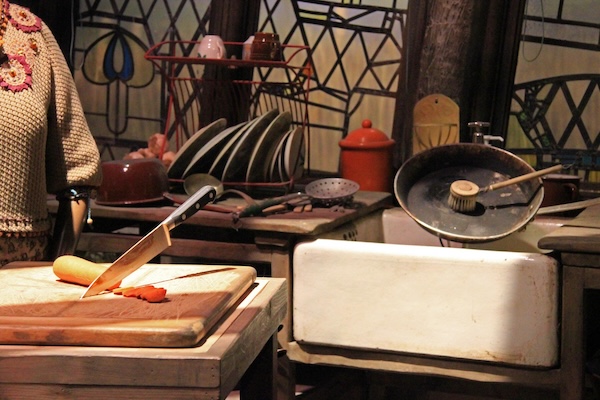There may not be magic at hand to prepare dinner or clean up afterwards, but the Weasleys’ home in the Harry Potter series, the Burrow, is a good model for how to welcome guests, with Mrs. Weasley’s always sharing her love, food, home, and even her motherly reprimands with others. (photo by Karen Roe / flickr)
This winter, I felt our household was in hibernation. Between endless viruses brought home from middle school and -30˚C temperatures in Winnipeg, I doubted we’d ever emerge. Then, our household caught a break. We’ve had a few weeks now where all four of us seem mostly healthy. Also, there has been a rare moment of “early spring,” where temperatures are around freezing, the sun is out and everyone seems cheerful about the deep, goopy slush.
We have started to dig ourselves out. Not from the snow, but from all the activities we piled up during the coldest time of year. One kid removed his slot car racers and a 3D printer project from the dining room. Another kid tidied up a huge set he’s building for his video production class. There are still too many books and knitting projects on the coffee table (my fault). My husband even cleaned up his piles of paper. Why all the hurry? Well, suddenly people are coming over again to visit. We’re hopefully emerging from our long retreat.
During our hibernation, we stayed home, went to work and school, and to synagogue. That was mostly it. But then I got an email out of the blue. When I walk my setter-mix dog, we often encounter a tiny dog, Lulu, and her human, and we chat. Deep into our winter sojourn, we weren’t seeing Lulu or her people much, it was just too cold. Yet Lulu’s people, thoughtful neighbours, invited us over for cheese fondue, wine and a warm chat. After a great night out a block from home, I realized how small our world had become. I decided we owed them a dinner invitation. They’re coming (probably without Lulu) for Shabbat dinner this week.
I’ve always enjoyed cooking big Shabbat and holiday dinners for friends and having great conversations at the table. I was raised with this kind of hospitality. My parents’ home was always open to my friends, who timed their visits to enjoy their favourite foods or discuss things with my parents or siblings, and their friends, too. However, over the years, I’d really cut back on these dinners. First, because my twins still go to bed early. Then, because of the pandemic. After Oct. 7, I felt wary about the outside world and wanted to feel safe at home. About a year ago, I stopped inviting people. I could say it was because I was concentrating on my twins’ b’nai mitzvah preparations or the event itself, with friends and family visiting, but that was last June. This winter, we’ve been sick and it’s been so cold.
On one Shabbat at synagogue, I heard an impromptu talk from a young adult visiting home. He was serving in the Israel Defence Forces as a lone soldier and spent part of his time at home talking to groups about what was happening in Israel, and we discussed how to combat antisemitism in Canada. At this event, a community member suggested that inviting friends and allies over, perhaps to Shabbat dinner, could help others learn about who we are and gather more support.
What happened afterwards, along with the warmer, slushy weather, is that some of our friends began to seek us out.
Last week, an amazing acquaintance, who used to run a gallery we loved, asked me to sign one of my books for her friend’s birthday. Of course, I said, come on over. I showed her our “new” historic house and she brought me tulips.
Then, a longtime artist friend in her 80s contacted me and decided she was coming over the next morning for muffins and coffee, so she could show off her newest marbled paper experiments.
Last week, a retired newspaper columnist that I really respect happened to spot my husband outdoors with the dog. He started to text with my husband and asked to come see how we’d renovated things. My husband said yes. Our neighbourhood’s full of old houses with interesting quirks, so visiting each other’s homes is always fun. They’re coming for coffee and cake on Sunday. It seemed like high time to pick up the dog toys from the living room carpet.
All of these encounters with warm people who sought us out and wanted to get back in touch? None of them is Jewish. All of them are people who want us to know they are safe, they care about us, and they value our company. This was an important realization, well worth the effort it takes to clean up the messy paw prints and kid fingerprints for a visit.
When I imagine how I want my home to appear to friends, or even strangers, I think of the Burrow, the Weasleys’ home in the Harry Potter series. Well, that’s not quite right. Our house doesn’t use magic to knit sweaters or stir pots of soup. Those are my hands, my knitting and my cooking, instead. However, whenever I think of the Burrow, I think of a warm, welcoming place where Mrs. Weasley feeds everybody and makes everyone feel welcome and loved, despite the normal clutter and chaos of family life.
My notion of hachnasat orchim (welcoming guests) comes from Jewish tradition, a much older playbook than the Harry Potter series. However, the meaning feels the same, even if my household menu includes hamantashen and chicken soup. Mrs. Weasley’s always sharing her love, food, home, and even her motherly reprimands with others, and it goes beyond her family. Her home, the Burrow, sounds like a retreat, but it’s not a hibernation. It’s an enthusiastic embrace.
I am hoping to get back to that safe and cheerful place, where our home is full again with fascinating friends, good food, stimulating conversation and an open heart. Our gardens are still under dirty snow here. It sometimes takes a heroic effort to rise above winter weather and the residual sadness of the war, but good things await. Things are warming up at my house in Manitoba. I’m hoping for happier days ahead.
Joanne Seiff has written regularly for the Winnipeg Free Press and various Jewish publications. She is the author of three books, including From the Outside In: Jewish Post Columns 2015-2016, a collection of essays available for digital download or as a paperback from Amazon. Check her out on Instagram @yrnspinner or at joanneseiff.blogspot.com.



